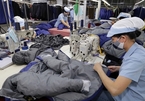In its report on the implementation of the National Assembly’s resolutions on the financial sector, the government gave assessments and compared the business results of different economic sectors in 2018.

Biggest taxpayer
SOEs had total assets of VND2,900 trillion, while state-invested joint stock companies had VND777 trillion, FIEs VND5,700 trillion, and private enterprises VND26,500 trillion.
Regarding revenue, FIEs had VND6,300 trillion, just second to private enterprises (VND13,500 trillion). SOEs had VND1,500 trillion in revenue, and state-invested equitized enterprises VND643 trillion.
The ROA (return on assets) of SOEs was 5.64 percent, while the ratio of pre-tax profit on total assets of state-invested equitized enterprises was 6.28 percent. The figures were 5.97 percent for FIEs and 2.22 percent for private enterprises.
If considering the rate of profit before tax on equity, the figures were 12.11 percent for SOEs, 15.98 percent for state invested enterprises, and13.64 percent for FIEs. It was just 6.76 percent for private enterprises.
The figures show that Vietnam’s private enterprises are still weak, but are the biggest taxpayers with the amount of paid taxes far higher than other enterprises, including FIEs.
In 2018, SOEs paid VND267.98 trillion in taxes to the state, state invested joint stock companies VND99,729 trillion, FIEs VND186.371 trillion, while private enterprises paid VND365.422 trillion.
Great potential
Private enterprises hold the most total assets, nine times more than the assets of SOEs, 34 times more than state invested enterprises, and five times more than FIEs.
Their stockholder equities were six times higher than SOEs, 29 times higher than state invested enterprises, and three times higher than FIEs.
Nevertheless, only 38 percent of private enterprises are profitable.
The government, after analyzing the statistics, commented that there is great potential for private enterprises to develop, and that it is necessary to support the private sector, which will be a strong driving force for Vietnam’s economic development.
Meanwhile, FIEs, with advantages in technology, management skill and investment incentives, paid 70 percent of the total taxes paid by SOEs.
State-invested joint stock companies operate most effectively, which can be seen in their ROA and ROE indexes higher than other economic sectors. This once again proves that equitizing SOEs and divesting from SOEs is the right decision.
Meanwhile, SOEs, especially state-owned economic groups and general corporations, continue to play an important role in the economy, operating effectively (nearly equal to FIEs, just second to state invested enterprises), and making great contributions to the state budget to serve investment and development.
L. Bang

Equitisation doesn't necessarily mean a better future for SOEs
Equitisation should be a magic wand to improve the performance of a State-owned enterprise (SOE), but in some cases, it is not.

Tax cut welcome but not enough: businesses
The Government's 30% corporate income tax cut was a step in the right direction but it could have been more inclusive by offering support to small businesses that were in desperate need of cash due to the difficulties caused by the COVID-19 pandemic.